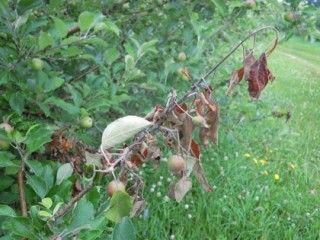
- First obvious symptoms in the orchard are dead blossoms or dark brown leaves hanging from a truss or branch.
- These result from spring or summer infection of blossom.
- The bark of diseased areas or branches (cankers) is dark-green or dark brown, often water soaked and with an indistinct margin between healthy and infected tissue.
- Shoot infection on apple is characteristic. Initially the tips wilt and droop without browning and at this stage golden droplets of bacterial ooze are often seen on the affected stem. Later, leaves and stem become brown.
- Symptoms also appear on fruit as brown irregular blotches, resembling bruises or sun scorch. Ooze present in warm, humid weather.
- During warm humid weather, a glistening whitish/cream bacterial slime may ooze from affected shoots, branches and fruits.
- In dry weather, ooze becomes desiccated and appears as a silvery film on affected surfaces.
Other problems that may be confused with fireblight
Fireblight symptoms can be confused with other diseases on apple that result indeed blossoms or cankers, e.g., Nectria canker and blossom wilt (Monilinia laxa f.sp. mali).
- Most easily confused is blossom wilt, especially on cider apples.
- Usually the two are readily distinguished as blossom wilt is characterised by the striping on branches where the blossom wilt fungus is advancing from the dead blossom.
- However on cider apples, often the only symptom of blossom wilt is dead blossoms as the disease does not always progress into the spur.
- So, unless there is evidence of fungal sporulation or bacterial ooze on the blossoms, visual diagnosis is difficult.
- Also blossom wilt and fireblight may be present in the same cider orchard.
